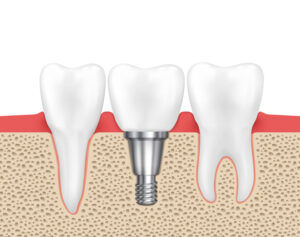
by Dr. Jacqueline S. Allen | Oct 24, 2016 | Blog, Dental Implants, Endodontics, Root Canal
 Dental implants have been offered in recent years as a panacea for fixing the problem of ailing teeth. However, the reality when it comes to treating a badly injured or infected tooth is more complex. Both endodontic procedures such as root canals and dental implants have their proper place – your dental care team can help determine what treatment will be most effective for you.
Dental implants have been offered in recent years as a panacea for fixing the problem of ailing teeth. However, the reality when it comes to treating a badly injured or infected tooth is more complex. Both endodontic procedures such as root canals and dental implants have their proper place – your dental care team can help determine what treatment will be most effective for you.
Here are four common myths related to dental implants, and the factual situation in each case.
Myths related to dental implants and root canal treatments
Myth #1: The best thing to do in all cases with an injured or infected tooth is to replace it with a dental implant.
There are a range of factors that will determine if a dental implant or a root canal is the best way to proceed. Although dental implants would appear at first glance to permanently resolve the issue with a troubled tooth, they can also cost more and require more visits to the dentist to complete. Most root canal treatments, which remove inflamed pulp and clean, fill and seal the inside of the tooth, can be accomplished in a single visit and are virtually painless.
Myth #2: Dental implants have a higher success rate than root canals.
A number of studies have shown both dental implants and root canals can have success rates of more than 95 percent. Currently, both procedures are considered excellent choices for treating an ailing tooth, and decisions to go with one procedure over the other should be based on factors related to an individual’s unique situation.
Myth #3: If you have a root canal and it fails, you need to have an extraction done and a dental implant placed.
Not necessarily. Root canals can fail for reasons that include damage to the crown protecting the treated tooth, additional tooth decay, or hidden canals that were not properly cleaned and filled the first time. However, endodontic retreatments of root canals can successfully restore the natural tooth to health in as many as 75% – 88% of all cases.
Myth #4: Your endodontist can’t help you if you need an implant.
Actually, the American Association of Endodontists has released a position statement affirming that if a endodontist determines a tooth must be extracted and a dental implant placed, he or she may proceed with the extraction and the placement of the implant if it is in the best interest of the patient.
“The decision whether to save a natural tooth or to proceed with an extraction and dental implant can be a difficult one,” says Dr. Jacqueline S. Allen, who practices with the Phoenix Endodontic Group. “Your endodontist can help you sort through your options and make the best decision for your individual health needs.”

by Dr. Jacqueline S. Allen | Oct 17, 2016 | Blog, Endodontics, Phoenix Endodontic Group
 At Phoenix Endodontic Group, we believe our staff is what makes our practice so successful! As part of our employee spotlight series, this month, we are highlighting Dallas Clary, one of our dental assistants! With over 17 years of experience in dentistry, she loves to disprove the negative reputation and impressions of endodontics and root canal procedures many patients have prior to treatment. Read on to learn more about Dallas!
At Phoenix Endodontic Group, we believe our staff is what makes our practice so successful! As part of our employee spotlight series, this month, we are highlighting Dallas Clary, one of our dental assistants! With over 17 years of experience in dentistry, she loves to disprove the negative reputation and impressions of endodontics and root canal procedures many patients have prior to treatment. Read on to learn more about Dallas!
Q: Tell us a little bit about yourself—where are you from? What hobbies do you enjoy?
A: I grew up in Eagar, AZ. I got my dental assisting degree from White Mountain School of Dental Assisting in Linden, AZ. As for hobbies, I love crafting, and Pinterest definitely inspires me!
Q: Did you always want to work in the dental industry? How did you end up at Phoenix Endo?
A: My mother worked in a dental office when I was growing up, so I guess I followed in her footsteps. Since I’ve worked in the endodontic industry for so long, I looked for an office closer to home, and fortunately, Phoenix Endo was looking for a dental assistant.
Q: What is your favorite part of working at Phoenix Endo?
A: I love helping patients have a comfortable and enjoyable experience during a root canal. It gives me great satisfaction to disprove the bad reputation that root canals have been given. Since they relieve the patient of pain, root canals shouldn’t be thought of negatively.
Q: What do you admire most about Dr. Allen?
A: Dr. Allen is so generous and truly cares for her patients and those in need. She spends tireless hours in and out of the office providing treatment to people.
Q: What are the most rewarding aspects of working at Phoenix Endo?
A: We have great doctors and a great team! We all work very hard to make sure that our patients have a great experience, despite the fact that they are having root canal treatment.
Tune in next month for to get to know another member of our team!

by Dr. Jacqueline S. Allen | Oct 12, 2016 | Blog, Endodontics, Root Canal
 Endodontically treated teeth can last a lifetime. Some of these teeth, however, may not heal properly or may develop new problems months, or even years, after they were initially treated. An additional endodontic treatment, called a retreatment (a second root canal procedure), can be performed, which could again, allow a patient to keep his or her tooth for a lifetime.
Endodontically treated teeth can last a lifetime. Some of these teeth, however, may not heal properly or may develop new problems months, or even years, after they were initially treated. An additional endodontic treatment, called a retreatment (a second root canal procedure), can be performed, which could again, allow a patient to keep his or her tooth for a lifetime.
Root canal treatment is like any other medical or dental procedure. It may not heal or respond to treatment, as expected for many different reasons:
- Often times, the permanent or temporary restoration may not have prevented salivary contamination inside the tooth.
- There may have been an extended period of time between when the crown or other restoration was placed, and when the root canal treatment was completed. Most endodontists and studies agree that a definitive restoration should be placed within one month following an endodontic procedure.
- There may be canals that were undetected, or canals that were too narrow, or calcified, to negotiate for the original practitioner.
There are occasions when a new problem arises with a tooth that has been treated previously that may compromise the original endodontic procedure:
- If a tooth develops a vertical fracture after endodontic therapy, it is no longer a viable tooth to keep in the oral cavity.
- A new cavity could develop in the tooth and expose the root canal to recontamination with bacteria.
- The restoration that was placed in or on the tooth after the endodontic treatment was complete can break down, creating microleakage of bacteria into the canals, which can cause recontamination.
Before endodontic retreatment is started, the endodontist may want to take a CBCT of the tooth. A CBCT is a 3-dimensional X-ray that allows the endodontist to look at the tooth in all planes to help diagnose a pattern of bone loss that may be indicative of a vertical fracture, canal anatomy that may not have been addressed in the original endodontic therapy, and other factors that will help your endodontist determine the best treatment for the tooth.
Even though a CBCT may offer more information about why a retreatment may be necessary, sometimes the endodontist must go back into the tooth and look for a potential cause that prevented the original root canal from healing.
A retreatment procedure consists of removal of the original contents of the crown and canals and exploration of the tooth and internal root structure that remains. If any canals were missed, they are addressed at that time. If a fracture exists, then the tooth will ultimately need an extraction, and may be removed at that time or may be removed at some point in the future by another practitioner. Once these issues are addressed, and once the canals are free of their filling material, they are disinfected, and an antibacterial paste is placed in each of them. This paste may be left in the tooth for several weeks until the tooth is symptom-free, and all other clinical signs of infection have disappeared. At that point, the patient returns, and the root canals would once again be filled with the endodontic filling material and a restoration crown would top the tooth. Most endodontists will evaluate the tooth for proper healing for several years after a retreatment is performed.
Although the goal of primary endodontic therapy is to save the natural tooth for a lifetime, there may be factors that can affect that overall outcome. When this happens, other treatments can save a natural tooth for a lifetime.

by Dr. Jacqueline S. Allen | Oct 3, 2016 | Apicoectomy, Blog, Root Canal
 Even though contemporary root canal procedures have very high success rates, not every root canal treatment is permanently effective. Tooth root systems can be complex, and undiscovered and untreated canals can harbor infections that threaten the pulp of a tooth months, or even years, after the initial procedure.
Even though contemporary root canal procedures have very high success rates, not every root canal treatment is permanently effective. Tooth root systems can be complex, and undiscovered and untreated canals can harbor infections that threaten the pulp of a tooth months, or even years, after the initial procedure.
If you’re experiencing pain and swelling around a tooth that’s received a root canal, visit your dentist or endodontist to have it examined. He or she may suggest that an endodontist perform an apicoectomy, which treats an infected tooth from its root end, rather than from the biting surface of the tooth.
Here’s a brief guide to how an apicoectomy can save a natural tooth that’s already received a root canal treatment.
Apicoectomy: A Step Beyond Root Canal Treatment
- Apicoectomies can be useful when a root canal retreatment won’t work. If the tooth has received a crown as part of its root canal process, or is part of a fixed dental bridge, those restorations will have to be disassembled and replaced to do another root canal. Accessing the infection through the root avoids this.
- An apicoectomy removes and seals the tip of the tooth root. During an apicoectomy, the endodontist will cut and lift the gum away from the tooth so the root is easily accessible. The infected tissue will be removed, along with the last few millimeters of the root tip. Then the endodontist cleans and seals the end of that root, removing a critical avenue where infection can manifest and cause problems.
- The preparation for an apicoectomy gives the endodontist an accurate picture of your natural tooth. Endodontists use state-of-the-art technology to perform apicoectomies, including fiber optic lights, operating microscopes and ultrasonic cleaning instruments that remove infection via high frequency vibration. Between this and the imaging technologies employed before the procedure, your endodontist will have an exceptionally clear picture of the health of your tooth, and what can be done to preserve it.
“If an infection threatens a tooth that’s had a root canal, and a retreatment isn’t an option, an apicoectomy can preserve it and keep it useful and functional for years to come,” says Dr. Allen of the Phoenix Endodontic Group.

by Dr. Jacqueline S. Allen | Sep 28, 2016 | Blog, Business
 You would think that the business of treating teeth with Root Canals in Scottsdale, Phoenix and Paradise Valley is boring business – I am here to tell you it is not. However, the workplace as we all used to know it has changed dramatically. This has to do mostly with changes in technology and the tools we use today to communicate with each other (internal), and with our patients and referring dentist offices (external).
You would think that the business of treating teeth with Root Canals in Scottsdale, Phoenix and Paradise Valley is boring business – I am here to tell you it is not. However, the workplace as we all used to know it has changed dramatically. This has to do mostly with changes in technology and the tools we use today to communicate with each other (internal), and with our patients and referring dentist offices (external).
Indeed the world has changed and rules that used to guide worker behavior and habits may no longer apply. Compared to today’s workplace, it feels like I began my business career at a time when “dinosaurs roamed the earth.” Contacting your co-workers wasn’t always just sending an Instant Message. Back in the day you had to be a little more creative.
1) Smoke Signals: Back when bartering was the foremost form of commerce, telling everyone that you had some hides to trade was as easy as sending a plume of smoke into the sky.
2) Morse Code: Samuel Morse brought texting to the 1830’s using dots and dashes, making it possible to ask your staff to”–..-/ -.-…–..”* without leaving your chair!
3) Long-Distance Calls: During the 1960’s, international calls would cost about $3.00 per minute – the equivalent of $25.00 today.
* Get my Coffee
Even in the stodgy old profession of dentistry, social media has forever changed the way business is done and how people communicate. If you are in pain and you need a root canal in Scottsdale, chances are you just type “Root Canal Scottsdale” into Google. Once you have found the name Phoenix Endodontic Group first in the search, you then access our web page and Facebook page. I am pretty sure that is how it is done today.
Mobile devices allow dental office staff to be more efficient and to look at information on their office in real time. This creates a challenge – understanding where the line is between work and personal as it relates to use of your own mobile device at work.
Here are 3 tips regarding social media/texting for employees in today’s workplace:
1. Put Family and Friends on Hold: Taking a few moments for personal calls and texts is ok as long as you keep it brief. Tell family members your hours so they know when they’ll hear back from you.
2. Friend request the Company, NOT your boss: Befriending coworkers and your boss on social media is a bad idea – you don’t want to mix work and play. That said, sharing company content online is a nice way to promote your company.
3. Texting at work is OK: Nowadays you are expected to be easily accessible which means email, messaging and even texting are all appropriate forms of workplace communication within office hours.
At Phoenix Endodontic Group, our staff understands that communication in our personal relationships and work relationships are constantly evolving and it’s important to be able to adapt in order to have a good work/life balance.

by Dr. Jacqueline S. Allen | Sep 14, 2016 | Blog, Cracked Teeth, Endodontics
 Tooth pain is almost always a signal that something is wrong inside your mouth and that you need to see a dentist immediately. The last thing you want to worry about in this situation is what day of the week it is.
Tooth pain is almost always a signal that something is wrong inside your mouth and that you need to see a dentist immediately. The last thing you want to worry about in this situation is what day of the week it is.
Specialists with the Phoenix Endodontic Group, like many other Scottsdale endodontists, are able to see emergency cases on the weekend. However, what if you’re in pain, but not sure if it’s bad enough for you to see your Scottsdale endodontist? Here is a quick guide for assessing your weekend dental emergency and determining the best course of action to resolve it.
Weekend Dental Emergency Guide
- When to call 911. Some conditions mandate immediate medical care, including jaw fractures, jaw dislocations, lacerations of the soft tissues of the mouth and face, or an abscessed or infected tooth that is severely swollen and/or impacting one’s breathing or swallowing. The emergency room staff can stabilize your condition, so that your Scottsdale endodontist can then safely provide treatment to preserve your teeth.
- When to call your Scottsdale endodontist. If you’re not experiencing symptoms that are life-threatening, it’s appropriate to call your dentist or endodontist and request to be seen immediately. Cases of cracked and knocked-out teeth fall in this category. If you have badly decaying teeth and are experiencing symptoms of dental infection, you may need an emergency root canal treatment. Don’t hesitate to ask for weekend treatment – in these cases, you will be preventing a potential trip to the ER, not to mention reducing your pain.
- When to practice self-care at home. If your dental pain is very mild, you may choose to apply some self-care techniques over the weekend and call your Scottsdale endodontist on Monday. Avoid extremely hot or cold foods and beverages, take over-the-counter pain relievers for your toothache and gargle with warm salt water to keep the area clean. If your symptoms get worse, don’t hesitate to make a weekend appointment to address the situation.
“Your treatment for your dental emergency should be predicated on what symptoms you have, not the date on the calendar, says Dr. Allen of the Phoenix Endodontic Group. “Our practice, or that of any Scottsdale endodontist, will be happy to see you get care during a weekend dental emergency situation.”

 Dental implants have been offered in recent years as a panacea for fixing the problem of ailing teeth. However, the reality when it comes to treating a badly injured or infected tooth is more complex. Both endodontic procedures such as root canals and dental implants have their proper place – your dental care team can help determine what treatment will be most effective for you.
Dental implants have been offered in recent years as a panacea for fixing the problem of ailing teeth. However, the reality when it comes to treating a badly injured or infected tooth is more complex. Both endodontic procedures such as root canals and dental implants have their proper place – your dental care team can help determine what treatment will be most effective for you.

 At Phoenix Endodontic Group, we believe our staff is what makes our practice so successful! As part of our employee spotlight series, this month, we are highlighting Dallas Clary, one of our dental assistants! With over 17 years of experience in dentistry, she loves to disprove the negative reputation and impressions of endodontics and root canal procedures many patients have prior to treatment. Read on to learn more about Dallas!
At Phoenix Endodontic Group, we believe our staff is what makes our practice so successful! As part of our employee spotlight series, this month, we are highlighting Dallas Clary, one of our dental assistants! With over 17 years of experience in dentistry, she loves to disprove the negative reputation and impressions of endodontics and root canal procedures many patients have prior to treatment. Read on to learn more about Dallas!
 Endodontically treated teeth can last a lifetime. Some of these teeth, however, may not heal properly or may develop new problems months, or even years, after they were initially treated. An additional endodontic treatment, called a retreatment (a second root canal procedure), can be performed, which could again, allow a patient to keep his or her tooth for a lifetime.
Endodontically treated teeth can last a lifetime. Some of these teeth, however, may not heal properly or may develop new problems months, or even years, after they were initially treated. An additional endodontic treatment, called a retreatment (a second root canal procedure), can be performed, which could again, allow a patient to keep his or her tooth for a lifetime.
 Even though contemporary root canal procedures have
Even though contemporary root canal procedures have  You would think that the business of treating teeth with Root Canals in Scottsdale, Phoenix and Paradise Valley is boring business – I am here to tell you it is not. However, the workplace as we all used to know it has changed dramatically. This has to do mostly with changes in technology and the tools we use today to communicate with each other (internal), and with our patients and referring dentist offices (external).
You would think that the business of treating teeth with Root Canals in Scottsdale, Phoenix and Paradise Valley is boring business – I am here to tell you it is not. However, the workplace as we all used to know it has changed dramatically. This has to do mostly with changes in technology and the tools we use today to communicate with each other (internal), and with our patients and referring dentist offices (external).
 Tooth pain is almost always a signal that something is wrong inside your mouth and that you need to see a dentist immediately. The last thing you want to worry about in this situation is what day of the week it is.
Tooth pain is almost always a signal that something is wrong inside your mouth and that you need to see a dentist immediately. The last thing you want to worry about in this situation is what day of the week it is.